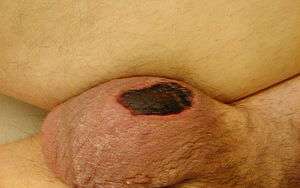Fournier gangrene
Fournier gangrene is a type of necrotizing fasciitis or gangrene affecting the external genitalia or perineum. It commonly occurs in older men, but it can also occur in women and children. It is more likely to occur in diabetics, alcoholics, or those who are immunocompromised.
| Fournier gangrene | |
|---|---|
 | |
| Specialty | Infectious disease |
| Frequency | 1 per 62,500 males a year[1] |
About one per 62,500 males are affected per year.[1] Males are affected about 40 times more often than females.[1] It was first described by Baurienne in 1764 and is named after a French venereologist, Jean Alfred Fournier, following five cases he presented in clinical lectures in 1883.[2]
Signs and symptoms
Initial symptoms of Fournier gangrene include swelling or sudden pain in the scrotum, fever, pallor, and generalized weakness. It is characterized by pain that extends beyond the border of the demarcated erythema. [2] Most cases present mildly, but can progress in hours. Subcutaneous air is often one of the specific clinical signs, but is not seen in >50% of presenting clinical cases. More marked cases are characterized by a foul odor and necrotic infected tissue. Crepitus has been reported.[2] It begins as a subcutaneous infection. However, necrotic patches soon appear in the overlying skin, which later develop into necrosis.[2]
Cause
Most cases of Fournier gangrene are infected with both aerobic and anaerobic bacteria such as Clostridium perfringens. It can also result from infections caused by group A streptococcus (GAS), as well as other pathogens such as Staphylococcus aureus and Vibrio vulnificus.[3] Lack of access to sanitation, medical care, and psychosocial resources has been linked to increased mortality.[4]
A 2006 Turkish study reported that blood sugar levels were elevated in forty-six percent of patients diagnosed with Fourniers.[5] Another study reported that about one-third of patients were alcoholic, diabetic, and malnourished, while another ten percent had been immunosuppressed through chemotherapy, steroids, or malignancy.[6]
Fournier gangrene is a recognized side effect of SGLT2 inhibitors (canagliflozin, dapagliflozin, and empagliflozin),[7][8] which increase the excretion of glucose in the urine.
Diagnosis
Fournier gangrene is usually diagnosed clinically, but laboratory tests and imaging studies are used to confirm diagnosis, determine severity, and predict outcomes.[2] X-rays and ultrasounds may show the presence of gas below the surface of the skin.[2] A CT scan can be useful in determining the site of origin and extent of spread.[2]
Treatment
Fournier gangrene is a urological emergency requiring intravenous antibiotics and debridement (surgical removal) of dead tissue.[2] In addition to surgery and antibiotics, hyperbaric oxygen therapy may be useful and acts to inhibit the growth of and kill the anaerobic bacteria.[9]
Prognosis
While recent case series (n=980) studies have found a mortality rate of 20–40%, a large (n=1641) 2009 study reported a mortality rate of 7.5%.[10]
Epidemiology
A 2009 epidemiological study found the incidence of Fournier gangrene to be 1.6 cases per 100,000 males, in the United States.[10] Males 50 to 79 years old had the highest rate at 3.3 per 100,000.[10] Of 1,680 cases identified in the study, 39 were women.[10]
Notable cases
Historically notable cases include Herod the Great, his grandson Herod Agrippa, and possibly the Roman emperor Galerius. Puerto Rican abolitionist and pro-independence leader Segundo Ruiz Belvis died from Fournier gangrene in November 1867. Harvey Weinstein suffered from Fourier gangrene; accuser Jessica Mann stated she felt “compassion” for Weinstein due to the severity of his genital disfigurement and at first believed him to be intersex.[11][12]
References
- Hamdy, Freddie C.; Eardley, Ian (2017). Oxford Textbook of Urological Surgery. Oxford University Press. p. 76. ISBN 9780191022524.
- Mallikarjuna, MN; Vijayakumar, A; et al. (2012). "Fournier's gangrene: Current practices". ISRN Surgery. 2012: 942437. doi:10.5402/2012/942437. PMC 3518952. PMID 23251819.
- Thwaini, A; Khan, A; et al. (2006). "Fournier's gangrene and its emergency management". Postgrad Med J. 82 (970): 516–9. doi:10.1136/pgmj.2005.042069. PMC 2585703. PMID 16891442.
- Kessler, CS; Bauml, J (November 2009). "Non-Traumatic Urologic Emergencies in Men: A Clinical Review". West J Emerg Med. 10 (4): 281–7. PMC 2791735. PMID 20046251.
- Yanar, H; Taviloglu, K; et al. (2006). "Fournier's gangrene: Risk factors and strategies for management". World J Surg. 30 (9): 1750–4. doi:10.1007/s00268-005-0777-3. PMID 16927060.
- Tahmaz, L; Erdemir, F; et al. (2006). "Fournier's gangrene: Report of thirty-three cases and a review of the literature". Int J Urol. 13 (7): 960–7. doi:10.1111/j.1442-2042.2006.01448.x. PMID 16882063.
- "FDA warns about rare occurrences of a serious infection of the genital area with SGLT2 inhibitors for diabetes". www.fda.gov. Center for Drug Evaluation and Research. 7 September 2018. p. Drug Safety and Availability. Retrieved 16 April 2019.
- Bersoff-Matcha SJ, Chamberlain C, Cao C, Kortepeter C, Chong WH (June 4, 2019). "Fournier Gangrene Associated With Sodium–Glucose Cotransporter-2 Inhibitors: A Review of Spontaneous Postmarketing Cases". Ann Intern Med. 170 (11): 764–769. doi:10.7326/M19-0085. PMID 31060053.CS1 maint: multiple names: authors list (link)
- Zamboni, WA; Riseman, JA; Kucan, JO (1990). "Management of Fournier's gangrene and the role of hyperbaric oxygen". J. Hyperbaric Med. 5 (3): 177–86. Retrieved 2008-05-16.
- Sorensen, MD; Krieger, JN; et al. (2009). "Fournier's gangrene: Population based epidemiology and outcomes". The Journal of Urology. 181 (5): 2120–6. doi:10.1016/j.juro.2009.01.034. PMC 3042351. PMID 19286224.
- "The Making of a Predator – Air Mail". airmail.news. Retrieved 2020-06-13.
- Vincent, Isabel (2020-06-13). "Harvey Weinstein's deformed penis explained". Page Six. Retrieved 2020-06-13.
External links
| Classification | |
|---|---|
| External resources |
- Fournier gangrene and Jean Alfred Fournier at Who Named It?